Stored Grain Pests
Stored Grain Pests
In India, post-harvest losses caused by unscientific storage, insects, rodents, micro-organisms etc., account for about 10 percent of total food grains. The major economic loss caused by grain-infesting insects is not always the actual material they consume, but also the amount contaminated by them and their excreta, which makes food unfit for human consumption. About 500 species of insects have been associated with stored grain products. Nearly 100 species of insect pests of stored products cause economic losses
Storage insect pests are categorised into two types:
- Primary storage pests : Internal and External feeders
- Secondary storage pests
Primary storage pests: Insects that damage sound grains are primary storage pests
Secondary storage pest: Insects that damage broken or already damaged grains are secondary storage pests.
Primary storage pests
Worldwide and is found practically throughout India. It is the most destructive pest on stored grain. The rice weevil may be found in the paddy fields as well.
Host range: Rice, sorghum, wheat, barley, maize
Bionomics: A Full-grown larva is 5 mm in length and a plump, fleshy, legless creature. The reddish-brown beetle adult is 3 mm in length, with a cylindrical body and a long, slender, curved rostrum. Its elytra bear four light reddish or yellowish spots.
The rice weevil breeds from April to October and hibernates in winter as an adult inside cracks and crevices or under wheat bags in the godowns. During the active season, females lay about 400 eggs on the grain by making a depression and the hole is sealed with a gelatinous secretion. Eggs hatch in 6-7 days and the young larvae bore directly into grain, where they feed and grow to maturity.


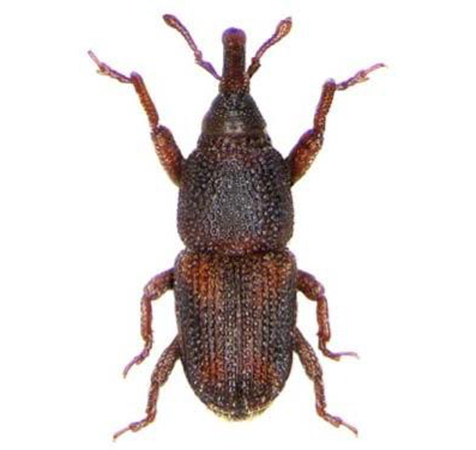
Then, they pupate inside the grain. The pupal stage lasts 6-14 days. On emergence, an adult weevil cuts its way out of the grain and lives for about 4-5 months. At least generations are completed in a year.


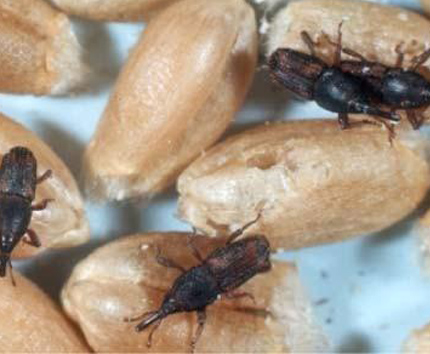
Both the adults and the grubs cause damage. The developing larva lives and feeds inside the grain causing irregular holes of 1.5 mm diameter on grains of rice, sorghum, wheat, barley, and maize before harvest and in storage. The weevils destroy more than what they eat.
2. Lesser grain borer: Rhyzopertha dominica (Bostrychidae: Coleoptera)
Distribution and status: India, Algeria, Greece, United States, New South Wales (Australia), Japan China.
Host range: Wheat, rice, maize, sorghum, barley, lentils, army biscuits, ship biscuits, stored, dried potatoes, corn flour, beans, pumpkin seeds, tamarind seeds and millets.
Bionomics: The larva is about 3mm long, dirty white, with a light-brown head and a constricted elongated body. The adult is a small cylindrical beetle measuring about 3 mm in length and less than 1 mm in width. It is shining dark brown with a deflexed head, covered by a crenulated hood-shaped pronotum. No morphological difference separates the two sexes.
The pest breeds from March to November and in December, it enters hibernation as an adult or as a larva.


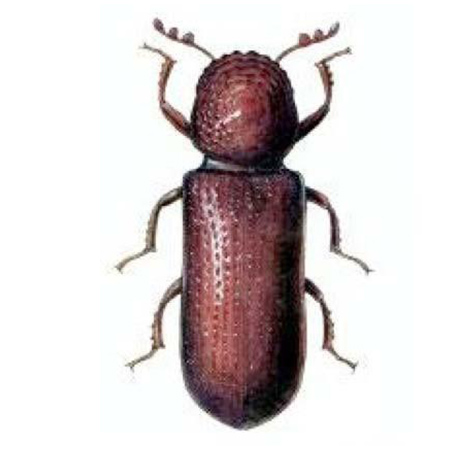
A single female can lay 300-400 eggs in 23-60 days at the rate of 4-23 eggs per day. The eggs are laid singly among the frass or are glued to the grain in batches. When freshly laid, the eggs are glistening white, but later on, a pink opaque line appears on them. The incubation period is about 5-9 days.
Larva cuts a circular hole in the pedicel end of the eggs and comes out of it. The larval period is 23–50 days, the pupal period is 4–6 days and adults live for about 40–80 days. There are 5 – 6 generations in a year.


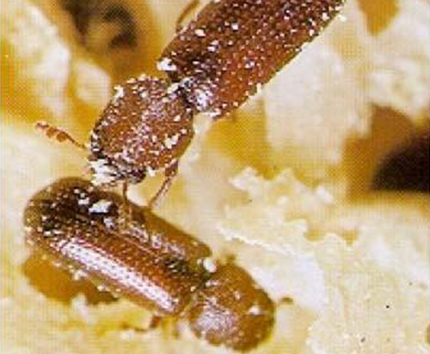
Damage symptoms
Both the adults and the grubs cause damage. The adults and grubs bore into the grains and feed them, reducing them to mere shells with many irregular holes. The adults are powerful fliers and migrate from one godown to another, causing fresh infestations. Adults produce a considerable amount of frass, spoiling more than what they eat.
3. Angoumois grain moth: Sitotroga cerealella (Gelechiidae: Lepidoptera) Distribution and status
worldwide. In the Indian subcontinent, the pest is more abundant in mountainous areas or where the climate is rather mild.
Host range: Paddy, wheat, maize, sorghum, barley, oats, etc.
Bionomics: A full-grown larva is about 5 mm long, with a white body and yellow-brown head. The adult is a buff, grey, yellow, brown or straw-coloured moth, measuring about 10-12 mm in wing expanse. The characteristic feature is the presence of narrow, pointed wings fringed with long hair.
Breeding takes place from April to October. The insect overwinters as a hibernating larva and as the season warms up, it pupates in early spring. Females start laying eggs singly or in batches on or near the grain. The eggs are small and white when freshly laid, turning reddish later on.


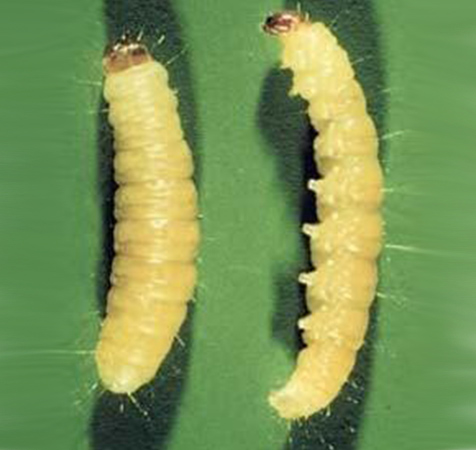
A single female lays, on average, 150 eggs, usually within a week after mating. The egg period is 4-8 days. The larval stage may last about 3 weeks. Before pupation, the larva constructs a silken cocoon in a cavity. The pupal period is 9 -12 days and the adult lives for about 4–10 days. During the active season, the life cycle is completed in about 50 days. Several generations were completed in a year.


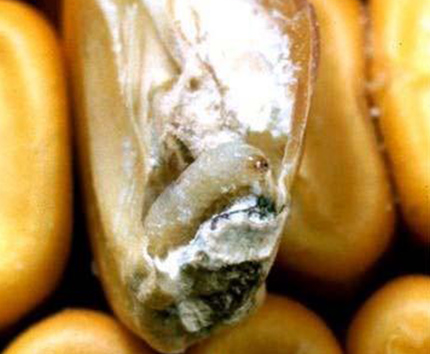
Damage symptoms
Both the adults and the grubs cause damage. The adults and grubs bore into the grains and feed them, reducing them to mere shells with many irregular holes. The adults are powerful fliers and migrate from one godown to another, causing fresh infestations. Adults produce a considerable amount of frass, spoiling more than what they eat.
4. Pulse beetle: Callosobruchus maculatus (chinensis) (Bruchidae: Coleoptera) Distribution and status
USA, Mauritius, Formosa, Africa, China, the Philippines, Japan, Indonesia, Sri Lanka, Myanmar and India.
Host range: Gram, mung (Phaseolus aureus), moth (Phaseolus aconitifolius), peas, cowpeas, lentils and arhar (Cajanus cajan), cottonseed, sorghum and maize.
Bionomics: Larva is whitish with a light-brown head. The mature larva is 6-7 mm long. The adult beetle, measuring 3-4 mm in length, is oval, chocolate or reddish brown and has long serrated antennae and truncate elytra, not covering the pygidium.
The pest breeds actively from March to the end of November. It hibernates in winter in the larval stage. A single female lays small, oval, scale-like 34-113 eggs at a rate of 1-37 per day. The egg period is 6 -16 days, and the larval period is 10 -38 days.


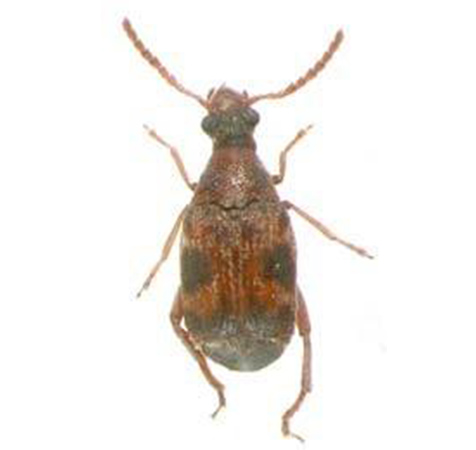
The hibernating larvae take 117- 168 days to complete their development. The pupal stage lasts 4-28 days. The adult escapes by cutting a circular hole in the seed coat and such grains can be spotted easily. The average lifespan of an adult is 5-20 days. The insect passes through 7-8 overlapping generations in a year.


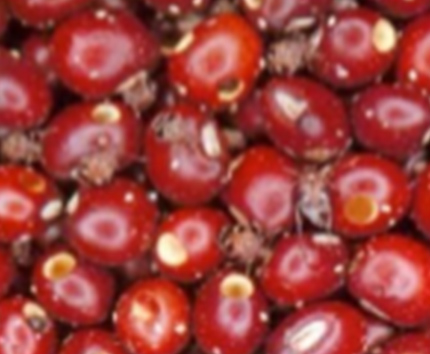
Damage symptoms
The adult and grub feed on the grain by making a small hole. Infested stored seed can be recognised by the white eggs on the seed surface and the round exit holes with the ‘flap’ of the seed coat. Kabuli types are particularly susceptible.
It feeds on the surface of the grains. It attacks cereal grains, flour and other eatables.
5. Cigarette beetle: Lasioderma serricorne (Anobiidae: Coleoptera) Bionomics
Adult light brown round beetle with its thorax and head bent downwards and this presents a strongly humped appearance to the insect. The elytra have minute hairs on them. Antenna is of uniform thickness. The creamy whit oval eggs are laid on the surface of stored material and the incubation period is 9- 14 days. The larval and pupal periods range respectively from 17 – 29 days and 2-8 days. Grub whitish hairy grub.
Damage symptoms
Both grubs and adults bore into tobacco products viz., cigarettes, cheroots and chewing tobacco. Presence o f circular pin head sized bore holes on processed tobacco is the typical symptom of attack. It also attacks the grain of wheat, peanut, cocoa, bean, cotton seed etc.


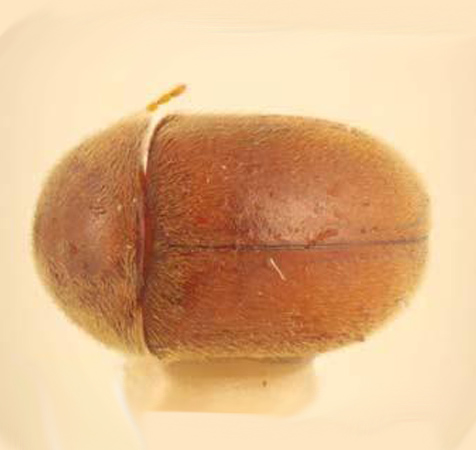


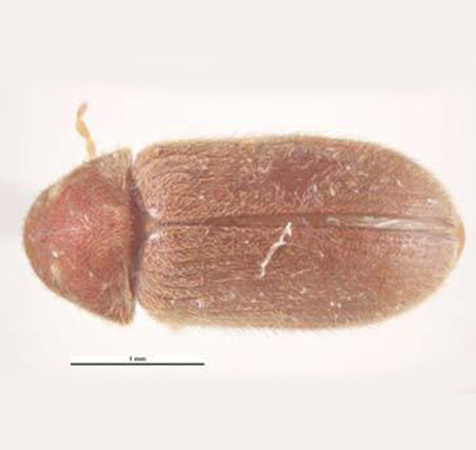
6. Drug store beetle: Stegobium paniceum (Anobiidae: Coleoptera)
Bionomics: Adult reddish brown small beetle has striated elytra and measured 3mm long. Antenna is clubbed. It lays the eggs in batches of 10 – 40. Grub is not hairy but is pale white, fleshy with the abdomen terminating in two dark horny points. LP: 10 – 20 and PP: 8 -12 days.
Damage symptoms
Circular pin-head sized bore hole on turmeric, coriander, ginger, dry vegetable and animal matter.
7. Tamarind beetle: Pachymeres gonagra (Bruchidae: Coleoptera)
Small grey coloured adult. makes circular holes on fruits of tamarind both in tree and storage.


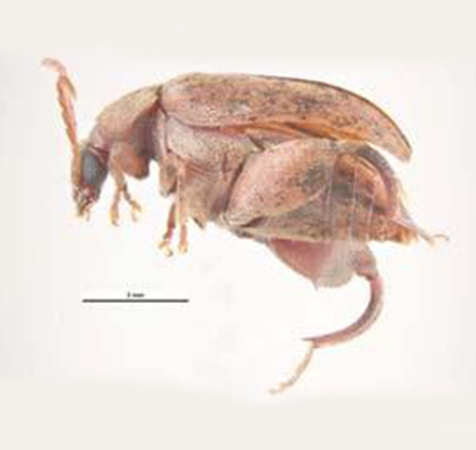



Bionomics: Whitish apodous with brown head. Adult is slender ant like with a long snout and shiny black with reddish brown thorax and legs. Grubs and adults bore into the tubers and make them unfit for consumption. Damage occurs both in field and storage
Bionomics: Larva is pale greenish. Adult is small with narrow fringed wings; forewings grey brown with dark spots and hindwings dirty white. Damage occurs both in field and storage. Tubers bored by caterpillars associated with fungal or bacterial infection


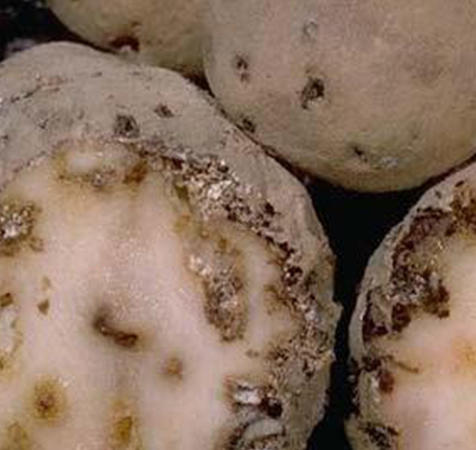


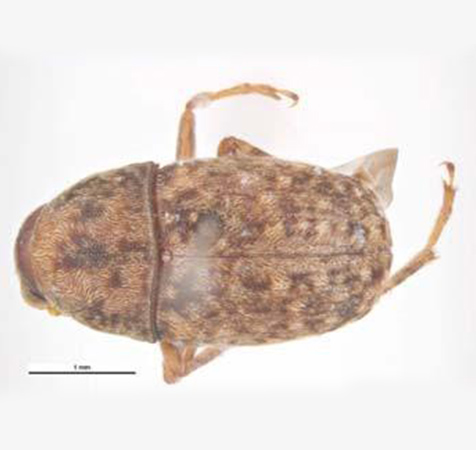
10. Arecanut beetle: Araecerus fasciculatus (Anthribidae: Coleoptera)
Bionomics: Adult is grey brown.
Damage symptoms
Internal content is eaten leaving outer coat intact. Causes more contamination than the actual damage. Coffee, cocoa, spices, maize, groundnut, brazilnut, dried cassava roots and processed foods.
External Feeders
1. Red flour beetle: Tribolium castaneum (Tenebrionidae: Coleoptera)
Distribution and status Worldwide
Host range: Wheat-flour, dry fruits, pulses and prepared cereal foods, such as cornflakes.
Bionomics: Adult is grey brown.The young larva is yellowish white and measures 1mm in length. As it matures, it turns reddish yellow, be The insect breeds from April to October and passes the winter mostly in the t sitsage2.5The females lay whit days. Pupation takes place in the flour. The pupa is yellowish and hairy. The pupal stage lasts 5-9 days. The development period from egg to the adult is 26-30 days in summer Damage symptoms Both the larvae and adults cause damage. The greatest damage is during the hot and humid monsoon season. The larvae are always found hidden in the food.


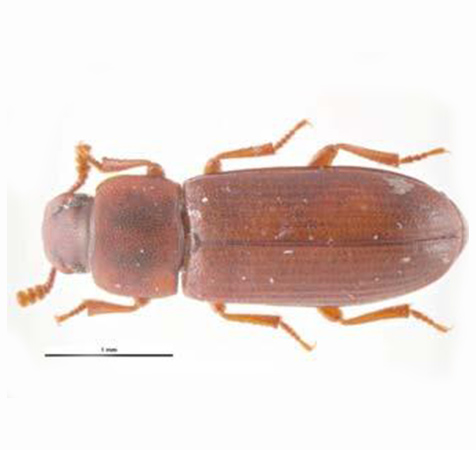
The adults, however, are active creatures, but mostly found concealed in flour. Adult construct tunnels as they move through flour and other granular food products. In severe infestation, the flour turns greyish and mouldy, and has a pungent, disagreeable odour making it unfit for human consumption.


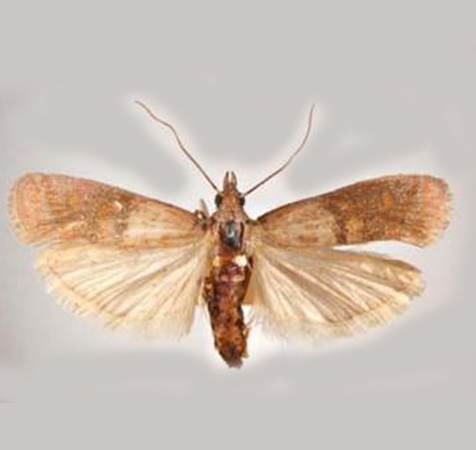
2. Indian meal moth: Plodia interpunctella (Phycitidae: Lepidoptera)
Distribution and status The pest is worldwide
Host range: It infests grains, meals, breakfast foods, soybean, dried fruits, nuts, s, dried roots, herbs, dead insects, etc.
Bionomics: Larva is white, often tinged with green or pink, a light-brown head, On reaching maturity, the larva is 8-3mm in length. The adult moth is about 13-20mm in wing expanse with a coppery lustre.
Breeding continues throughout the year. The female moth lays 30-350 minute whitish ovate eggs, singly or in clusters, on or near the appropriate foodstuffs. The egg period is 2 days to 2 weeks depending upon weather. The larvae become full-grown in 30-35 days.
They crawl up to the surface of the food material and pupate within a thin silken cocoon. The pupal stage lasts 4-35 days. In summer, the life-cycle is completed in 5 or 6 weeks and there are about 4-6 generations in a year.
Damage symptoms
Only the larva causes damage. Crawling caterpillars completely web over the surface of a heap of grains with silken threads. The adults fly from one bin to another and spread the infestation.
3. Almond Moth / Fig moth: Ephestia cautella (Pyralidae:Lepidoptera)
The pest is also known as the dried currant moth.
Distribution and status Worldwide
Host range: It is a serious pest of dried fruits such as currants, raisons, dried apples, dates, berries, figs, almonds, walnuts, tamarind seeds, etc. It has also been recorded on lac, malted milk, dried mango, pulp, garlic bulbs, various cereal grains and grain products.
Bionomics: The adult moth has greyish wings with transverse stripes on the outer region and the wing expanse is about 12 mm. The female lays whitish eggs indiscriminately in cracks and crevices of the receptacles or on the food stuff. While feeding, the larvae spin tubes in the food material and are full-grown in 40-50 days. The full-grown larva is white with pinkish tinge and measures 1.5 cm. The larvae pupate inside the cocoons and pupal stage lasts about 12 days. The life cycle is completed in about two months and there are 5-6 generations in a year.


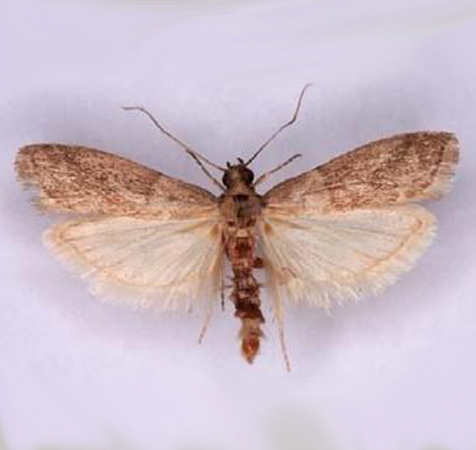


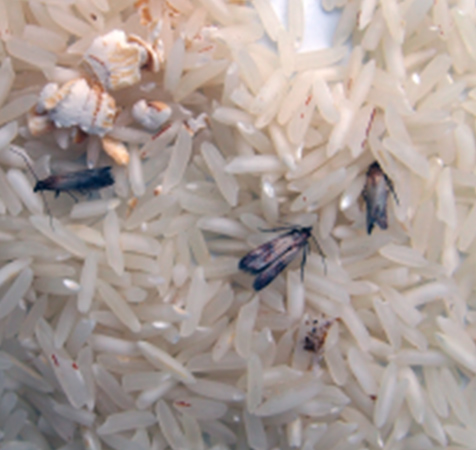
4. Rice moth: Corcyra cephalonica (Pyralidae: Lepidoptera)
Distribution and status The rice moth is distributed in Asia, Africa, North America and Europe. In the larval stage, it is an important stored-grain pest in both India and Pakistan.
Host range: It also infests rice, sorghum, maize, gram, groundnut, cotton-seed, milled products, cocoa beans and raisins.
Bionomics: The rice moth is active from· March to November. It passes winter in the larval stage. The moth lay eggs singly or in groups of 3-5 each on the grains, bags and on other objects in the godowns. A single female lay 62-150 eggs during its life- span of 24 days. The eggs hatch in 4-7 days and the larvae under silken web-like shelters, preferring the partially damaged grains. They are full-fed in 21-41 days, after which they make silken cocoons among the infested grains. The pupal stage lasts 9-14 days and the adults live for – one week. They complete life-cycle in 33-52 days and the pest completes approximately 6 generations in a year.
Damage symptoms
The larvae alone damage the grains of rice and maize by feeding under silken webs. When infestation is high, the entire stock of grains may be converted into a webbed mass. Ultimately, a characteristic foul odour develops and the grains are rendered unfit for human consumption.
5. Khapra beetle: Trogoderma granarium (Dermestidae: Coleoptera)
The pest is also known as the dried currant moth.
Distribution and status Worldwide
Host range: The Khapra beetle will attack any dried plant or animal matter. It prefers grain and cereal products, mainly wheat, barley, oats, rye, maize, rice, flour, malt, and noodles. It can also feed on animal products such as dead mice, dried blood, and dried insects
Bionomics: The insect breeds from April to October and hibernates in the larval stage from November to March in cracks and crevices. Female begins to lay white translucent eggs on the grains, singly or sometimes in clusters of 2 -5. The eggs are rather cylindrical, rounded at one end and narrow at the other. A female may lay 13 – 35 eggs in 1 – 7 days at the rate of 1 – 26 eggs per day.


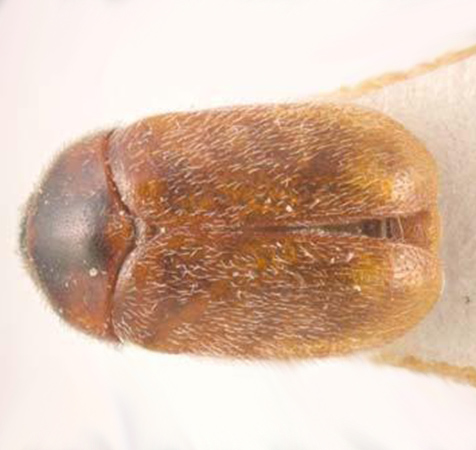
The egg period varies from 3 -10 days. Larval period is 20 – 40 days and pupal period is 4 – 6 days. Pupation takes place in the last larval skin among the grains. The adults are incapable of flying. There are 4-5 generations in a year.
Fresh yellowish-white larva grows 4mm long and turns brown. The adult is a small dark-brown beetle, 2-3 mm long, with a retractile head and clubbed antennae. The entire body is clothed in fine hairs.


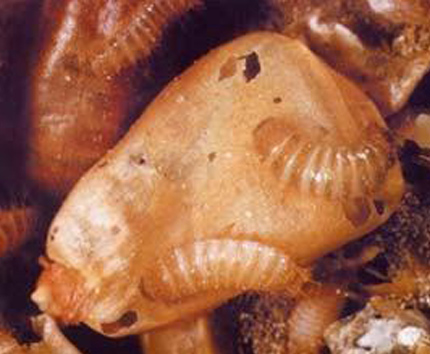
Damage symptoms
The greatest damage is done in summer from July to October. The grubs eat the grain near the embryo or at any other weak point and from there proceed inwards. They usually confine themselves to the upper 50 cm layer of grains in a heap or to the periphery in a sack of grains.
They can reduce the grain to a mere frass. Since the larvae are positively thigmotactic, they can be collected by merely placing gunny bags on a heap of grain.
Secondary pest
Bionomics: It is slender, dark, narrow, flattened beetle having a row of saw like sharp teeth on each side of the prothorax. The antenna is clubbed and elytra cover abdomen completely. It lays 300 whitish eggs loosely in cracks of storage receptacles of godown. The eggs period is 3 -17 days. The larva is slender, pale cream in colour with to slightly darken patches on each segment. The larval period is 14- 20 days. It pupates in a protective cocoon like covering with sticky secretion. The pupal period is 7-21 days.


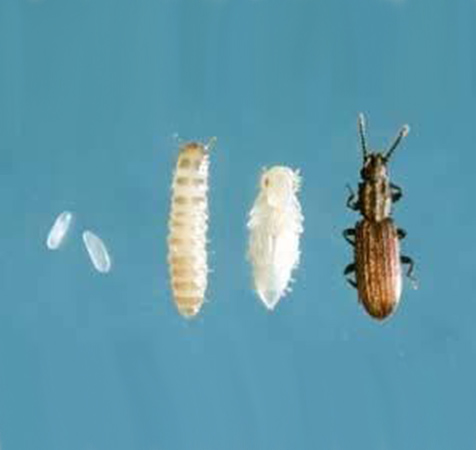


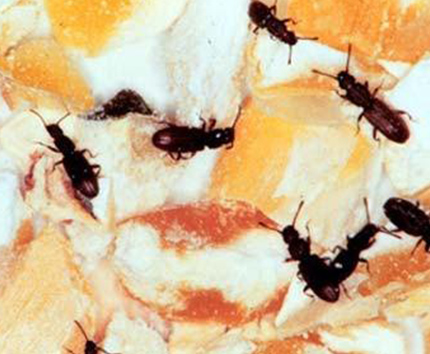
Damage symptoms
It feed on grains, dried fruits etc by scarving of grain surface or burrowing holes in them. It attacks rice, wheat, maize, cereal products, oil seeds and dry fruits.
2. Long headed flour beetle: Latheticus oryzae (Tenebrionidae: Coloeptera)
Bionomics:
The beetle is light brown in colour with longated body, measuring 2 -3 mm in length and resembles Tribolium castaneum. It lays 400 white eggs singly on grain and seams of the bags. The incubation period is 7 – 12 days. The grub is small, white active which feeds voraciously. The larval period is 15-80 days. It pupates for 5-10 days. Life cycle is completed in 25 days at 35 0 and 70% relative humidity. Resembles Tribolium. Head is longer in proportion to the body than that of Tribolium, paler and brighter than Tribolium.


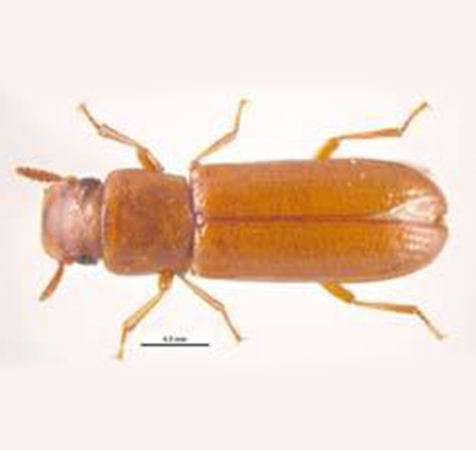
Damage symptoms
Both grubs and adult beetles feed on the milled products. It occurs as secondary infestation in stored grain. It attacks cereal flour, packaged food, rice and rice products. Occurs as secondary infestation in stored sorghum, wheat, etc.


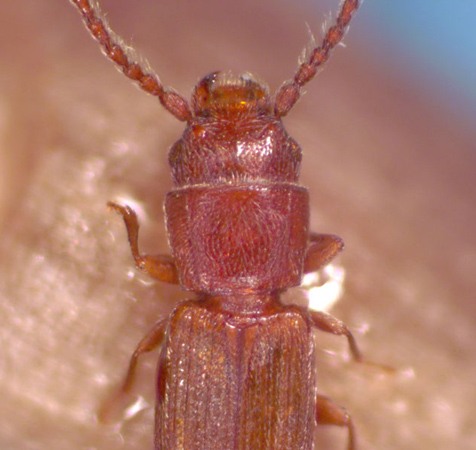
Damage symptoms
4. Grain lice: Liposcelis divinitorius (Psocoptera)
Bionomics: It is pale grey or yellowish white coloured, small, pin head sized louse with filiform antenna. It lays about 7-60 eggs. The metamorphosis is incomplete.


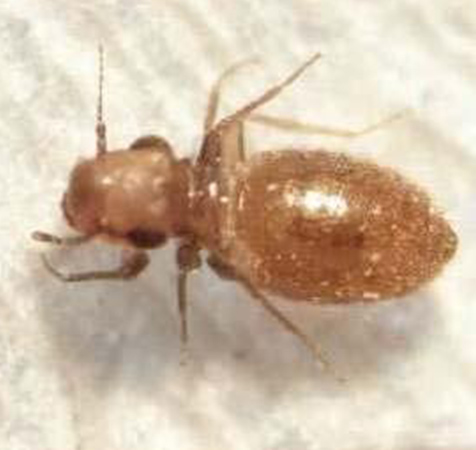
Damage symptoms
They are scavengers affecting only germ portion in heavy infestation. It thrive on insect fragments and broken grains. It attacks all starchy material.


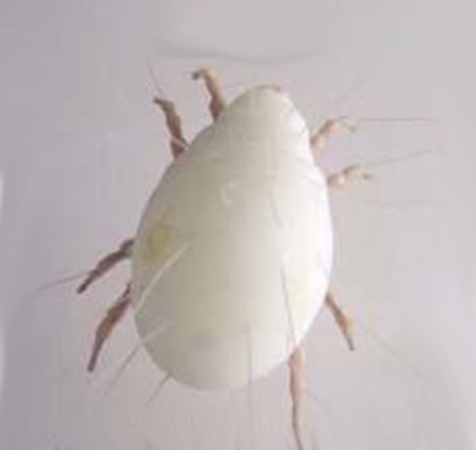
Bionomics: It is pale straw to dark reddish brown mite.It lays about 100 eggs. The eggs are hatched into 6 legged larvae which moult into nymphs. There are 1-3 instars. The life cycle is completed in 9-12 days at 23 0 C and 70 % relative humidity.
Damage symptoms
It feeds on the surface of the grains. It attacks cereal grains, flour and other eatables.
Minor Pests of Stored Grains)
The other insect species recorded as minor pests on stored grains and products in India are the; the cadelle, Tenebroides mauritanicus (Trogossitidae: Coleoptera) and the black fungus beetle, Alphitobius laevigatus (Tenebrionidae: Coleoptera)
Truly Nolen’s Stored Grain Pests Service employs Integrated Pest Management (IPM) techniques for optimal protection. Our pest control approach includes thorough monitoring, rigorous sanitation, and targeted treatments to prevent and control infestations. By combining these strategies, we ensure your stored grain remains safe, preserving its quality and value. Trust Truly Nolen for comprehensive pest control services and effective grain pest management.
Our Clients













Truly is present in more than 37 cities across the country, having more than 400 employees. TPS is currently serving 4000+ commercial and 10000+ residential clients, with an increasing list of clients on a daily basis.
- 915, Hemkunt Tower, 98 Nehru Place, New Delhi -110019.
© Truly Nolen 2023 . All Right Reserved. Designed By Verve Media.
